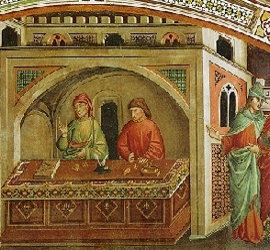During the Crusades (1095-1291), the Knights Templar established an elaborate credit network for the pilgrim routes to the Holy Land.
Pilgrims would deposit their money in a Templar stronghold in Europe in exchange for a letter of credit. When the pilgrim needed money, they presented the letter of credit at Templar positions en route.
By the end of the 12th century, the Knights Templar were serving as the de facto bankers to the kings of France and England, and transfered money from papal tax collectors to Rome.
The development of trade meant the appearance of new commercial and financial centers. Wealthiest of all were the Italian merchant-bankers, operating from the great trading cities of the Mediterranean, such as Venice and Genoa. Italian merchant-bankers appeared in London as early as 1224.

At first, there was a shortage of currency in trade as most of the gold and silver was being shipped to the Holy Land to finance the Crusades. Banking in the 13th century was a simple operation, and written instructions to a banker developed slowly. This was not the case in Italy, where many commercial activities were made through written contracts with no use of cash money. This was the origin of bills of exchange.
The most common type of bill of exchange is the cheque, which is defined as a bill of exchange drawn on a banker and payable on demand. Bills of exchange are used primarily in international trade, and are written orders by one person to his bank to pay the bearer a specific sum on a specific date sometime in the future. Prior to the advent of paper currency, which is a very current phenomenon, bills of exchange were a more significant part of trade.

As the use of currency increased in the later Middle Ages, the great number of coins in circulation and their different values led to a person specialized in the valuation and exchange of currency: the moneychanger. Soon, they were accepting deposits from their clients.
It was also the use of book-keeping which made Italian bankers rise above the rest. By the 14th century, they had learned to keep double-entry book-keeping in Genoa and even earlier in Tuscany. It was used throughout Italy and the Italian banking houses of western Europe but apart from this it was not widespread. At first, this important advancement seemed exclusive to Italian bankers, whether at home or abroad.
By the end of the 13th century, banking activity had shifted to Florence, under the Medici Family. The Medici Bank was a group of partnerships which became famous in the later Middle Ages and was influential in the early Renaissance. Expansion came when many of its smaller rivals became bankrupt, due to the unbalanced nature of trade in this period. Soon, the Medici had banks throughout Europe in the cities of Bruges, London, and Venice. This newfound wealth through trade and banking ushered in the Renaissance and the European Age of Exploration.

United States Series 1957 A $1 Silver Certificate -- A Bill of Exchange
in which the bearer could receive $1 worth of silver
in exchange for this bill. It was soon realized that simply exchanging the Bill
was much more efficient. Hence the Dollar Bill
.
